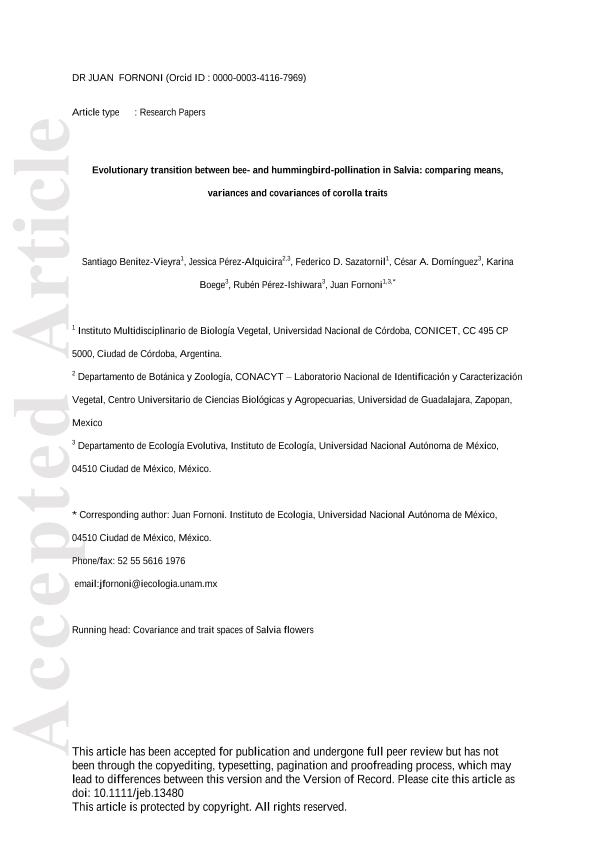Artículo
Evolutionary transition between bee pollination and hummingbird pollination in Salvia: Comparing means, variances and covariances of corolla traits
Benitez-Vieyra, Santiago Miguel ; Pérez-Alquicira, Jessica; Sazatornil, Federico David
; Pérez-Alquicira, Jessica; Sazatornil, Federico David ; Domínguez, César A.; Boege, Karina; Pérez Ishiwara, Rubén; Fornoni, Juan Enrique
; Domínguez, César A.; Boege, Karina; Pérez Ishiwara, Rubén; Fornoni, Juan Enrique
 ; Pérez-Alquicira, Jessica; Sazatornil, Federico David
; Pérez-Alquicira, Jessica; Sazatornil, Federico David ; Domínguez, César A.; Boege, Karina; Pérez Ishiwara, Rubén; Fornoni, Juan Enrique
; Domínguez, César A.; Boege, Karina; Pérez Ishiwara, Rubén; Fornoni, Juan Enrique
Fecha de publicación:
04/2019
Editorial:
Wiley Blackwell Publishing, Inc
Revista:
Journal of Evolutionary Biology
ISSN:
1010-061X
e-ISSN:
1420-9101
Idioma:
Inglés
Tipo de recurso:
Artículo publicado
Resumen
Covariation among traits can modify the evolutionary trajectory of complex structures. This process is thought to operate at a microevolutionary scale, but its long-term effects remain controversial because trait covariation can itself evolve. Flower morphology, and particularly floral trait (co)variation, has been envisioned as the product of pollinator-mediated selection. Available evidence suggests that major changes in pollinator assemblages may affect the joint expression of floral traits and their phenotypic integration. We expect species within a monophyletic lineage sharing the same pollinator type will show not only similarity in trait means but also similar phenotypic variance-covariance structures. Here, we tested this expectation using eighteen Salvia species pollinated either by bees or by hummingbirds. Our findings indicated a nonsignificant multivariate phylogenetic signal and a decoupling between means and variance-covariance phenotypic matrices of floral traits during the evolution to hummingbird pollination. Mean trait value analyses revealed significant differences between bee- and hummingbird-pollinated Salvia species although fewer differences were detected in the covariance structure between groups. Variance-covariance matrices were much more similar among bee- than hummingbird-pollinated species. This pattern is consistent with the expectation that, unlike hummingbirds, bees physically manipulate the flower, presumably exerting stronger selection pressures favouring morphological convergence among species. Overall, we conclude that the evolution of hummingbird pollination proceeded through different independent transitions. Thus, although the evolution of hummingbird pollination led to a new phenotypic optimum, the process involved the diversification of the covariance structure.
Palabras clave:
COVARIANCE SPACE
,
MORPHOSPACE
,
PHENOTYPIC INTEGRATION
,
POLLINATION
,
SALVIA
Archivos asociados
Licencia
Identificadores
Colecciones
Articulos(IMBIV)
Articulos de INST.MULTIDISCIPL.DE BIOLOGIA VEGETAL (P)
Articulos de INST.MULTIDISCIPL.DE BIOLOGIA VEGETAL (P)
Citación
Benitez-Vieyra, Santiago Miguel; Pérez-Alquicira, Jessica; Sazatornil, Federico David; Domínguez, César A.; Boege, Karina; et al.; Evolutionary transition between bee pollination and hummingbird pollination in Salvia: Comparing means, variances and covariances of corolla traits; Wiley Blackwell Publishing, Inc; Journal of Evolutionary Biology; 32; 8; 4-2019; 783-793
Compartir
Altmétricas



